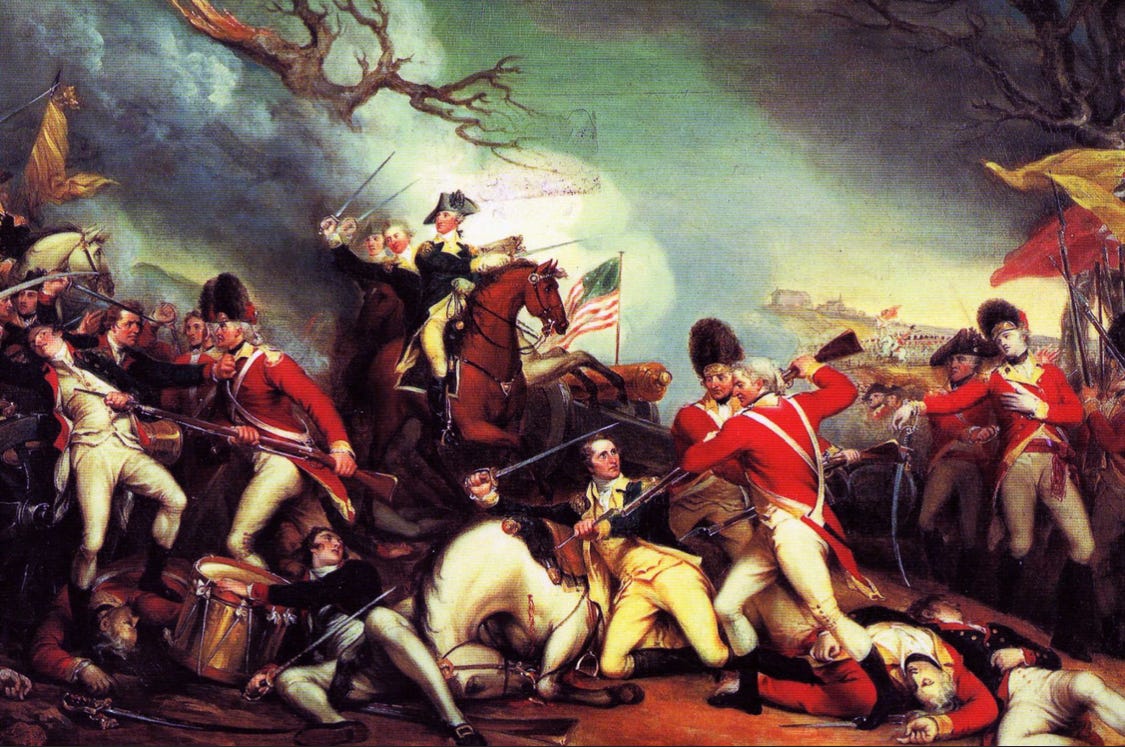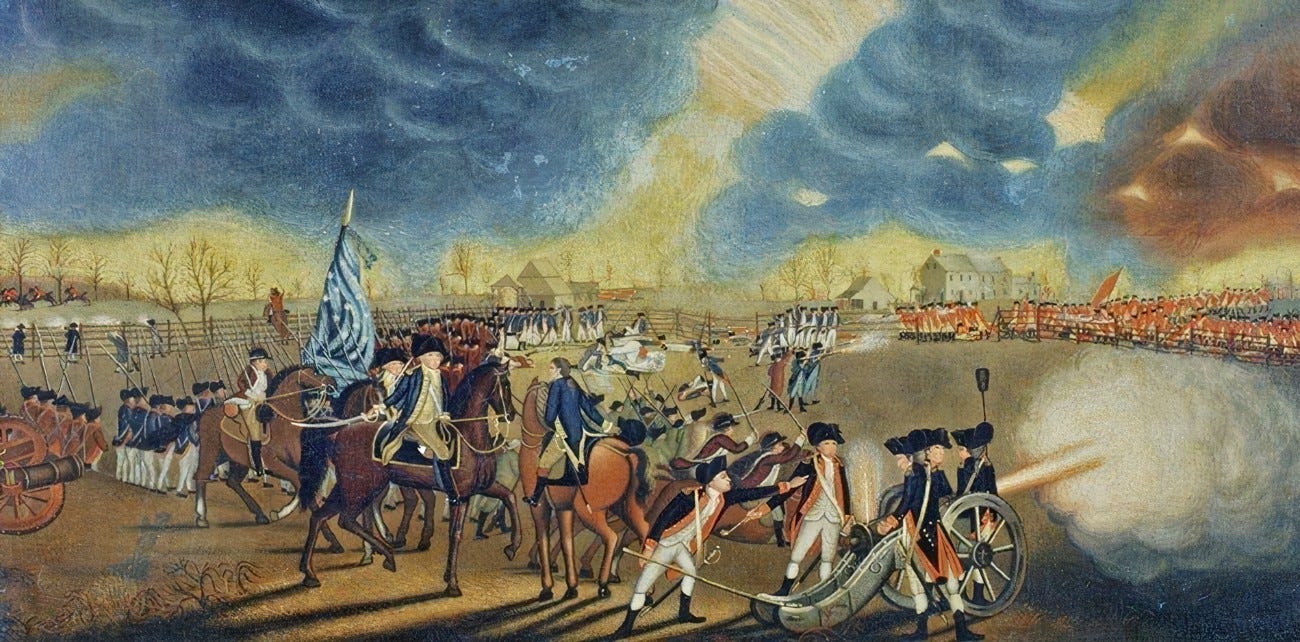Untold Stories: ‘Battle of Princeton’ by William Mercer, America’s First Deaf Artist
There are so many inspiring, beautiful stories about the great heroes of American history which are scarcely ever told. One happens on them accidentally—buried in a thick, out-of-print biography, in small print on a museum sign, casually and fleetingly mentioned in an obscure educational video. America cannot return to greatness in the future if we do not truly understand the greatness of our past. That is why I am writing an article series to tell a few of these little-known but moving or illustrative “untold stories” of American greatness.
Some of my previous articles in this series include Abraham Lincoln’s visits with the former slaves in the “contraband” camps, trailblazing Marines throughout US history, how Union Col. Trimble saved black freemen from Confederate enslavers, and how George Washington single-handedly ended dangerous infighting in the Revolutionary Army.
Today I want to look specifically at a painting by America’s first deaf artist, William Mercer. Mercer was not only popular and famous in his own right, however—his father was Brig. Gen. Hugh Mercer, friend and fellow officer of George Washington. To understand the painting, I first should explain Hugh Mercer’s background and his son’s.
Hugh Mercer was a good friend of George Washington’s (both were French and Indian War veterans), a Scottish immigrant, and an apothecary. He was appointed a brigadier general in the Revolutionary army and served with Washington during the hard year of 1776. He survived the crucial American victory at the Battle of Trenton, which was a turning point in the war, but was surrounded and bayoneted multiple times soon after by vindictive British soldiers during the Battle of Princeton in January 1777. Below is a famous depiction of Hugh Mercer’s death, by John Trumbull:

Mercer had a number of famous descendants, including Gen. George Patton and songwriter Johnny Mercer, and his son became the first deaf American artist. Two of Mercer’s sons were born both deaf and mute, George and William. William had definite artistic talent, however, so in 1783 George Weedon (guardian of the Mercer children after their father’s death) sent William to study painting with renowned artist and Revolutionary War veteran, Charles Willson Peale. Peale and William’s father Hugh Mercer had become friends in 1776 when they were both Patriot soldiers. After studying with Peale for three years, William Mercer returned to his home town of Fredericksburg, Virginia and “began his successful career as an acknowledged ‘excellent portraitist’ until his death in 1839.”1
Below is William Mercer’s depiction of the Battle of Princeton, with his father depicted in the center:
Unlike Trumbull’s depiction, William Mercer at first glance does not make his father one of the focal points, though Hugh Mercer is in the center (and the lighting of the sky points straight to him). In the painting, Hugh Mercer lies mortally wounded next to his fallen horse, one of his soldiers clasping the dying general in his arms. Mercer’s men are lined up against the fence, their guns on the ground in front of them, their British captors facing them. It is believed that Mercer was attacked so brutally because he would not surrender and because the British may have mistaken Mercer for George Washington, the commander-in-chief. In any case, Mercer died bravely, though cruelly—he did not die immediately from his multiple wounds, lingering for nine days.2
As I said, William Mercer does not paint his father as the main focal point of the painting’s foreground—Hugh Mercer’s death is the background, as it were, for the grouping in the front. On the right, American artillerists with their distinctive red facings on the blue coats fire toward the mass of redcoated British soldiers coming across the fields or firing from behind the fence. Nearer to where Hugh Mercer lies wounded, other American soldiers face off against a group of British, the two opposing groups of soldiers firing at point-blank range.
In the center and foreground of the painting American infantrymen fire at the British while a group of horsed officers stand behind them. George Washington is the central figure, brandishing a sword. William Mercer is apparently depicting the moment that Washington rushed onto the field and rallied his troops, preventing a disorderly retreat. Washington’s personal flag is behind him, with its blue background and six-cornered stars, clearly marking where the commander-in-chief is on the field.
Whether William Mercer intended to convey this particular message with his painting I do not know, but his The Battle of Princeton seems to blend excellently well both the tragedies and victories of war, with realism and idealism. George Washington, with his brandished sword, magnificent horse, and billowing flag, is the inspiring embodiment and cause of the Americans’ victory at the battle—commanding, calm, saving the day as he so often did. The foreground is all of victory.
But the background is the sober reality that victory in war always comes at a heavy cost. Hugh Mercer lies dying on the very field of victory, during a battle which was a for him in some sense a personal defeat—because he died. But Hugh Mercer died so that the American cause might live. And ultimately, I don’t think William Mercer meant to belittle his father’s death and sacrifice by making him small and far off, as it were, in the painting. Just as the line of light in the sky points straight to Hugh Mercer like a shining finger, marking out the dying hero for glory, Hugh Mercer’s death was a personal tragedy but he was participating in a battle that helped further the American cause.
William Mercer’s painting is a reminder not only that war brings death and tragedy, but also glory and victory. William did not paint an image of defeated disaster, but of conquerors turning the tide. Like William Mercer, we should focus not just on the tragedy of Hugh Mercer’s death at Princeton, but also everything that Hugh Mercer, George Washington, and their fellow Patriots dared and achieved in the cause of liberty.
The information and quote for this paragraph came from signs at Hugh Mercer Apothecary Shop museum in Fredericksburg, VA.
Dr. Benjamin Rush, who cared for the dying Mercer at the home of Thomas Clarke, said of the brigadier general, “the manner of his death was equally honorable to himself and to our cause.” Courtesy of Hugh Mercer Apothecary Shop museum.





